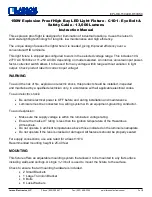
Maintenance
Note:
Determine the left and right sides of the machine from the normal operating position.
Note:
Download a free copy of the electrical or hydraulic schematic by visiting
www.Toro.com
and searching
for your machine from the Manuals link on the home page.
Maintenance Safety
•
Before you leave the operator’s position, do the
following:
– Park the machine on a level surface.
– Disengage and lower the cutting units.
– Engage the parking brake.
– Shut off the engine and remove the key.
– Wait for all movement to stop.
– Allow the machine to cool before adjusting,
servicing, cleaning, or storing it.
•
Allow machine components to cool before
performing maintenance.
•
If possible, do not perform maintenance while the
engine is running. Keep away from moving parts.
•
Support the machine with jack stands whenever
you work under the machine.
•
Carefully release pressure from components with
stored energy.
•
Keep all parts of the machine in good working
condition and all hardware tightened.
•
Replace all worn or damaged decals.
•
To ensure safe, optimal performance of the
machine, use only genuine Toro replacement
parts. Replacement parts made by other
manufacturers could be dangerous, and such use
could void the product warranty.
Recommended Maintenance Schedule(s)
Maintenance Service
Interval
Maintenance Procedure
After the first hour
• Torque the wheel lug nuts to 94 to 122 N∙m (70 to 90 ft-lb).
After the first 8 hours
• Check the condition and tension of the alternator belt.
After the first 10 hours
• Torque the wheel lug nuts to 94 to 122 N∙m (70 to 90 ft-lb).
After the first 50 hours
• Change the engine oil and filter.
• Check the engine speed (idle and full throttle).
Before each use or daily
• Inspect the seat belt(s) for wear, cuts, and other damage. Replace the seat belt(s) if
any component does not operate properly.
• Check the interlock switches.
•
• Check the level of the engine oil.
• Drain water and contaminants from the fuel-water separator.
• Check the tire air pressure.
• Check the coolant level.
• Remove debris from the screen, oil coolers, and radiator. (More frequently in dirty
operating conditions).
• Check the hydraulic-fluid level.
• Check the hydraulic lines and hoses.
• Check the reel to bedknife contact.
• Inspect the seat belt.
Every 50 hours
• Grease the bearings and bushings (and immediately after every washing).
• Service the battery.
Every 100 hours
• Inspect the cooling system hoses.
• Check the condition and tension of the alternator belt.
Every 150 hours
• Change the engine oil and filter.
Every 200 hours
• Drain moisture from the fuel and hydraulic fluid tanks.
39
















































